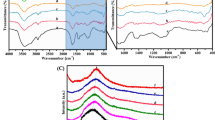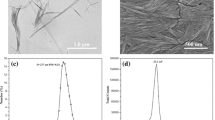Abstract
Interpenetrated gels of biocompatible polysaccharides alginate and silanized hydroxypropyl methyl cellulose (Si-HPMC) have been studied in order to assess their potential as scaffolds for the regeneration of human tissues. Si-HPMC networks were formed by reduction of the pH to neutral and alginate networks were formed by progressive in situ release of Ca2+. Linear and non-linear mechanical properties of the mixed gels at different polymer and calcium concentrations were compared with those of the corresponding single gels. The alginate/Si-HPMC gels were found to be stiffer than pure Si-HPMC gels, but weaker and more deformable than pure alginate gels. No significant difference was found for the maximum stress at rupture measured during compression for all these gels. The degrees of swelling or contraction in excess water at pH 7 as well as the release of Ca2+ was measured as a function of time. Pure alginate gels contracted by as much as 50 % and showed syneresis, which was much reduced or even eliminated for mixed gels. The important release of Ca2+ upon ageing for pure alginate gels was much reduced for the mixed gels. Furthermore, results of cytocompatibility assays indicated that there was no cytotoxicity of Si-HPMC/alginate hydrogels in 2D and 3D culture of human SW1353 cells. The results show that using interpenetrated Si-HPMC/alginate gels has clear advantages over the use of single gels for application in tissue regeneration.
Graphical Abstract






Similar content being viewed by others
References
Wu S, Liu X, Yeung KWK, Liu C, Yang X. Biomimetic porous scaffolds for bone tissue engineering. Mater Sci Eng Rep. 2014;80:1.
MacNeil S. Biomaterials for tissue engineering of skin. Materialstoday. 2008;11:26.
Hussain A, Collins G, Yip D, Cho CH. Functional 3-D cardiac co-culture model using bioactive chitosan nanofiber scaffolds. Biotechnol Bioeng. 2013;110:637.
Keane TJ, Badylak SF. Biomaterials for tissue engineering applications. Semin Pediatr Surg. 2014;23:112.
Vacanti JP, Langer R. Tissue engineering: the design and fabrication of living replacement devices for surgical reconstruction and transplantation. Lancet. 1999;354:32.
Vinatier C, Mrugala D, Jorgensen C, Guicheux J, Noël D. Cartilage engineering: a crucial combination of cells, biomaterials and biofactors. Trends Biotechnol. 2009;27:307.
Merceron C, Vinatier C, Clouet J, Colliec-Jouault S, Weiss P, Guicheux J. Adipose-derived mesenchymal stem cells and biomaterials for cartilage tissue engineering. Rev Rhum. 2008;75:942.
Bonaventure J, Kadhom N, Cohen-Solal L, Bourguignon KH, Lasselin C, Freisinger P. Reexpression of cartilage-specific genes by dedifferentiated human articular chondrocytes cultured in alginate beads. Exp Cell Res. 1994;212:97.
Drury JL, Mooney DJ. Hydrogels for tissue engineering: scaffold design variables and applications. Biomaterials. 2003;24:4337.
Hunziker EB. Articular cartilage repair: basic science and clinical progress. A review of the current status and prospects. Osteoarthr Cartil. 2001;10:432.
Lee KY, Mooney DJ. Hydrogels for tissue engineering. Chem Rev. 2001;101:1869.
Wu J, Wu D, Mutschler MA, Chu C-C. Cationic hybrid hydrogels from amino-acid-based poly(ester amide): fabrication, characterization, and biological properties. Adv Funct Mater. 2012;22:3815.
Wu J, Zhao X, Wu D, Chu C-C. Development of a biocompatible and biodegradable hybrid hydrogel platform for sustained release of ionic drugs. J Mater Chem B. 2014;2:6660.
Silva AKA, Juenet M, Meddahi-Pellé A, Letourneur D. Polysaccharide-based strategies for heart tissue engineering. Carbohydr Polym. 2014;116:267.
Sun JY, Zhao X, Illeperuma WRK, Chaudhuri O, Oh KH, Mooney DJ, Vlassak JJ, Suo Z. Highly stretchable and tough hydrogels. Nature. 2012;489:133.
Darnell MC, Sun JY, Mehta M, Johnson C, Arany PR, Suo Z, Mooney DJ. Performance and biocompatibility of extremely tough alginate/polyacrylamide hydrogels. Biomaterials. 2013;34:8042.
Lee KY, Mooney DJ. Alginate: properties and biomedical applications. Prog Polym Sci. 2012;37:106.
Fernández Farrés I, Norton IT. Formation kinetics and rheology of alginate fluid gels produced by in situ calcium release. Food Hydrocolloids. 2014;40:76.
Stephen AM, Phillips GO, Williams PA, editors. Food polysaccharides and their applications, 2nd ed. Boca Raton: Taylor & Francis Group; 2009.
Kuo CK, Ma PX. Ionically crosslinked alginate hydrogels as scaffolds for tissue engineering: Part 1. Structure, gelation rate and mechanical properties. Biomaterials. 2001;22:511.
Jang J, Seol YJ, Kim HJ, Kundu J, Kim SW, Cho DW. Effects of alginate hydrogel cross-linking density on mechanical and biological behaviors for tissue engineering. J Mech Behav Biomed Mater. 2014;37:69.
Fragonas E, Valente M, Pozzi-Mucelli M, Toffanin R, Rizzo R, Silvestri F, Vittur F. Articular cartilage repair in rabbits by using suspensions of allogenic chondrocytes in alginate. Biomaterials. 2000;21:795.
Chubinskaya S, Huch K, Schulze M, Otten L, Aydelotte MB, Cole AA. Human articular chondrocutes cultured in alginates beads maintain their gene expression. Cells Mater. 1998;8:151.
Chan G, Mooney DJ. Ca2+ released from calcium alginate gels can promote inflammatory responses in vitro and in vivo. Acta Biomater. 2013;9:9281.
Vinatier C, Magne D, Weiss P, Trojani C, Rochet N, Carle GF, Vignes-Colombeix C, Chadjichristos C, Galera P, Daculsi G, Guicheux J. A silanized hydroxypropyl methylcellulose hydrogel for the three-dimensional culture of chondrocytes. Biomaterials. 2005;26:6643.
Sarkar N. Thermal gelation properties of methyl and hydroxypropyl methylcellulose. J Appl Polym Sci. 1979;24:1073.
Allahbash S, Nicolai T, Chassenieux C, Tassin J-F, Benyahia L, Weiss P, Rethore G. Interplay of thermal and covalent gelation of silanized hydroxypropyl methyl cellulose gels. Carbohydr Polym. 2015;115:510.
Laib S, Fellah BH, Fatimi A, Quillard S, Vinatier C, Gauthier O, Janvier P, Petit M, Bujoli B, Bohic S, Weiss P. The in vivo degradation of a ruthenium labelled polysaccharide-based hydrogel for bone tissue engineering. Biomaterials. 2009;30:1568.
Allabash S, Nicolai T, Benyahia L, Tassin J-F, Chassenieux C. Evidence for the co-existence of interpenetrating permanent and transient networks of hydroxypropyl methyl cellulose. Biomacromolecules. 2014;15:311.
Bourges X, Weiss P, Daculsi G, Legeay G. Synthesis and general properties of silated-hydroxypropyl methylcellulose in prospect of biomedical use. Adv Colloid Interface Sci. 2002;99:215.
Fatimi A, Tassin JF, Turczyn R, Axelos MAV, Weiss P. Gelation studies of a cellulose-based biohydrogel: the influence of pH, temperature and sterilization. Acta Biomater. 2009;5:3423.
Acknowledgment
This work has been funded by the Agence Nationale de la Recherche in the framework of ANR-11-BSV5-0022.
Author information
Authors and Affiliations
Corresponding author
Electronic supplementary material
Below is the link to the electronic supplementary material.
Rights and permissions
About this article
Cite this article
Viguier, A., Boyer, C., Chassenieux, C. et al. Interpenetrated Si-HPMC/alginate hydrogels as a potential scaffold for human tissue regeneration. J Mater Sci: Mater Med 27, 99 (2016). https://doi.org/10.1007/s10856-016-5709-2
Received:
Accepted:
Published:
DOI: https://doi.org/10.1007/s10856-016-5709-2




